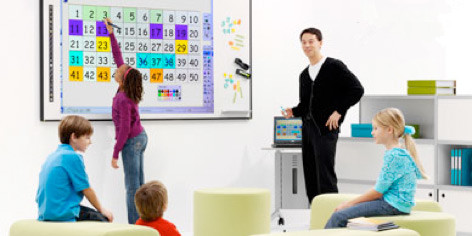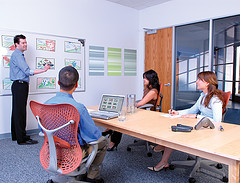Back
in the old days (the 80s and early 90s), blackboards in classrooms were the
norm. They were pretty much the same technology that our grandparents had seen
in their schooldays. Since then, we've seen a lot of innovation, with
whiteboards replacing the dusty old blackboard, before being replaced by
interactive whiteboards and flat panel displays.
These new interactive display devices have only been accepted in schools for a
little over a decade, but already they are becoming the new standard. In the
UK, 90% of all classrooms use them, with the US lagging behind at 40%. The
reasons for their wide acceptance are quite simple: they make life easier for
teachers and make lessons more engaging and fruitful for students.
Having already secured their future in the academic space, interactive display
manufacturers have set their sights on the corporate world. While it may seem
like a strange transition, it's worth remembering that many of the multimedia
presentation techniques used in education were originally developed for use in
presentations and meetings. The digital projector and Microsoft Powerpoint have
effectively paved the way for interactive displays. So, in a sense, the
corporate world is the spiritual home of the interactive display.
Interactive displays have a number of advantages over regular Powerpoint
presentations. Slide-based presentations lend themselves to a linear
presentation of data. But meetings are not linear events. People interact, ask
questions, and ask to refer back to things you mentioned 5 minutes ago.
With a Powerpoint presentation, you often reach the point where you switch the
projector off and start waving your hands instead, losing at least half your
audience. However, the simple interface of the interactive display such as
Intech's Large Touch Screen -5 Users(TS) series makes it easy for you to
control the presentation without disconnecting from your audience, and adapt
your presentation to their questions and feedback.
Besides, these presentations are digital files, which means that interested
parties can copy them and refer to them after the meeting, accessing the
information they need without going through the slides one by one.
The benefits mentioned above are quite similar to those experienced in
education: a smoother relay of information between presenter and audience, with
greater engagement and interactivity. Companies that are using interactive
displays in the boardroom and for staff briefings find that meetings and
presentations are faster, smoother, and more productive. These in turn have a
direct impact on management coordination and staff productivity, helping
companies remain agile and adapt quickly to changing circumstances. In other
words, the clever use of interactive displays confers a competitive advantage
to organizations and businesses.
Currently,
the fastest growing corporate markets are in the United States, UK, Germany,
and Sweden. As companies in different industries continue to benefit from
improved collaboration, it's only natural that their competitors will want to
emulate their success. So it won't be long before we see these devices in
the majority of boardrooms and conference spaces worldwide.
Previous:Five Essential Tips for Disciplined Interactive Board Sessions
Next:Interactive Conference Room Displays


